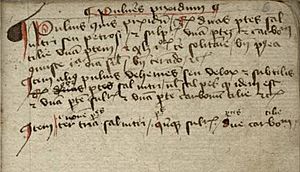Pilcrow facts for kids
Quick facts for kids ¶ |
|
|---|---|
|
Pilcrow
|
|
The pilcrow (¶) is a special mark used in writing. It's also called the paragraph mark or paragraph sign. This symbol helps show where one paragraph ends and a new one begins.
Long ago, before we used indents to start new paragraphs, the pilcrow was very important. It helped readers see a new idea or section of text. Famous writers like Eric Gill used it in their books.
The pilcrow usually looks like a small letter 'q' that stretches up and down. Sometimes, it looks like a backwards 'D', especially in older books.
How the Pilcrow Got Its Name and Shape
The word pilcrow comes from the ancient Greek word paragraphos. This word meant a horizontal line drawn next to the text. Over time, it changed through Old French words like paragraphe and pelagraphe. The word pylcrafte in Middle English, around 1440, was an early version of pilcrow.
The way we divide text has changed a lot. In ancient Greece, a simple horizontal line in the margin showed a new section. This line later changed into the Greek letter Gamma (Γ). Then, it became the letter 'K', which stood for the Latin word kaput, meaning "head" or "beginning".
Later, around 300 BC, the Latin word capitulum (meaning "little head" or "chapter") was used. So, the letter 'C' became the symbol for a new section. By the 1100s, 'C' had completely replaced 'K'. People who added color and designs to manuscripts, called rubricators, started adding lines to the 'C'. They filled it with dark ink, and it slowly changed into the pilcrow (¶) we see today.
Modern Uses of the Pilcrow
When printing presses were invented, there wasn't enough time for rubricators to draw pilcrows by hand. So, printers started leaving a blank space at the beginning of paragraphs instead. This is how the indent, or space, before paragraphs became common. But the pilcrow is still used in many ways today:
- In legal documents, the pilcrow helps people refer to a specific paragraph. This is useful in laws, court papers, or articles about law. It helps everyone find the exact part of the text being discussed.
- In school papers, it can be used to point to a specific paragraph in a document that doesn't have page numbers. This helps readers find where a certain idea or fact came from. For example, "¶3" would mean the third paragraph from the top.
- In proofreading, which is checking text for mistakes, the pilcrow shows where a long paragraph should be split into two or more shorter ones. The proofreader puts the pilcrow where the new paragraph should start.
- In some church services, especially in the Anglican church, the pilcrow is printed in the order of service. It tells the people in the church when to stand, sit, or kneel, and who should speak during different parts of the service.
- On the internet, some blogs and wikis use the pilcrow to show permalinks. These are special links that go directly to a specific part of a page.
- In computer programs like word processors, the pilcrow is often used as an icon on a toolbar. When you click it, you can see "hidden characters" like paragraph breaks, tabs, and spaces. This helps people see how their text is formatted. It also marks where you need to press the "Enter" key in typing practice programs.
- The pilcrow can also be used to mark a footnote in a document. It's often the sixth symbol in a series of special marks used for footnotes on a page.
See also
 In Spanish: Calderón (tipografía) para niños
In Spanish: Calderón (tipografía) para niños




